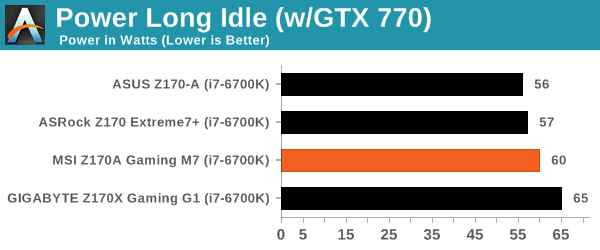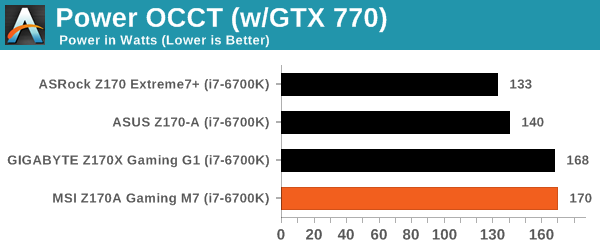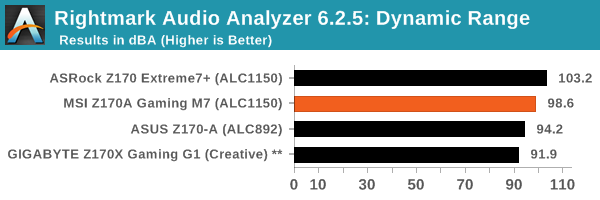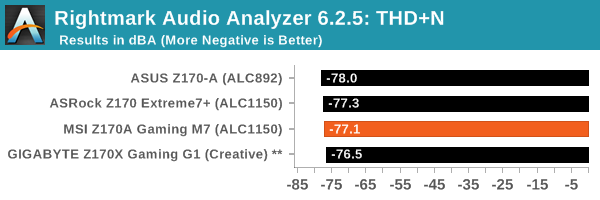The MSI Z170A Gaming M7 Review: The Step Up to Skylake
by Ian Cutress on September 21, 2015 12:30 PM EST- Posted in
- Motherboards
- Gaming
- MSI
- Skylake
- Z170
System Performance
Not all motherboards are created equal. On the face of it, they should all perform the same and differ only in the functionality they provide - however this is not the case. The obvious pointers are power consumption, but also the ability for the manufacturer to optimize USB speed, audio quality (based on audio codec), POST time and latency. This can come down to manufacturing process and prowess, so these are tested.
Power Consumption
Power consumption was tested on the system while in a single MSI GTX 770 Lightning GPU configuration with a wall meter connected to the OCZ 1250W power supply. This power supply is Gold rated, and as I am in the UK on a 230-240 V supply, leads to ~75% efficiency > 50W, and 90%+ efficiency at 250W, suitable for both idle and multi-GPU loading. This method of power reading allows us to compare the power management of the UEFI and the board to supply components with power under load, and includes typical PSU losses due to efficiency. These are the real world values that consumers may expect from a typical system (minus the monitor) using this motherboard.
While this method for power measurement may not be ideal, and you feel these numbers are not representative due to the high wattage power supply being used (we use the same PSU to remain consistent over a series of reviews, and the fact that some boards on our test bed get tested with three or four high powered GPUs), the important point to take away is the relationship between the numbers. These boards are all under the same conditions, and thus the differences between them should be easy to spot.



The MSI comes in on the latter end of our power testing, which might be related to the early BIOS used at the time of testing as well as the implementation of MultiCore Turbo similar to the Gaming G1. We did note that these early BIOSes do tend to implement a high stock voltage under load as well.
Windows 7 POST Time
Different motherboards have different POST sequences before an operating system is initialized. A lot of this is dependent on the board itself, and POST boot time is determined by the controllers on board (and the sequence of how those extras are organized). As part of our testing, we look at the POST Boot Time using a stopwatch. This is the time from pressing the ON button on the computer to when Windows 7 starts loading. (We discount Windows loading as it is highly variable given Windows specific features.)

Similarly, the early BIOS versions are unlikely to be optimised for POST. In this circumstance, a stripped BIOS caused some issues that exacerbated the POST time.
Rightmark Audio Analyzer 6.2.5
Rightmark:AA indicates how well the sound system is built and isolated from electrical interference (either internally or externally). For this test we connect the Line Out to the Line In using a short six inch 3.5mm to 3.5mm high-quality jack, turn the OS speaker volume to 100%, and run the Rightmark default test suite at 192 kHz, 24-bit. The OS is tuned to 192 kHz/24-bit input and output, and the Line-In volume is adjusted until we have the best RMAA value in the mini-pretest. We look specifically at the Dynamic Range of the audio codec used on board, as well as the Total Harmonic Distortion + Noise.


From the outset it seems that we will have a range of audio codecs being used on Z170, especially when each of the main manufacturers might have some additional software enhancements over the top. For example, the Creative featureset of the G1 can never be fully turned off, making a hardware analysis of the audio output difficult to the extent of being semi-meaningless. I fear this will only get more difficult as time goes on.
USB Backup
For this benchmark, we transfer a set size of files from the SSD to the USB drive using DiskBench, which monitors the time taken to transfer. The files transferred are a 1.52 GB set of 2867 files across 320 folders – 95% of these files are small typical website files, and the rest (90% of the size) are small 30 second HD videos. In an update to pre-Z87 testing, we also run MaxCPU to load up one of the threads during the test which improves general performance up to 15% by causing all the internal pathways to run at full speed.
Due to the introduction of USB 3.1, as of June 2015 we are adjusting our test to use a dual mSATA USB 3.1 Type-C device which should be capable of saturating both USB 3.0 and USB 3.1 connections. We still use the same data set as before, but now use the new device. Results are shown as seconds taken to complete the data transfer.

USB 3.0 (or USB 3.1 at 5 Gbps) is provided by the chipset/PCH, meaning we should see some consistency there, but the USB 3.1 at 10 Gbps can either be supplied by ASMedia or Intel, which might produce a spread of results.
DPC Latency
Deferred Procedure Call latency is a way in which Windows handles interrupt servicing. In order to wait for a processor to acknowledge the request, the system will queue all interrupt requests by priority. Critical interrupts will be handled as soon as possible, whereas lesser priority requests such as audio will be further down the line. If the audio device requires data, it will have to wait until the request is processed before the buffer is filled.
If the device drivers of higher priority components in a system are poorly implemented, this can cause delays in request scheduling and process time. This can lead to an empty audio buffer and characteristic audible pauses, pops and clicks. The DPC latency checker measures how much time is taken processing DPCs from driver invocation. The lower the value will result in better audio transfer at smaller buffer sizes. Results are measured in microseconds.

Ideally we hope for a drop in DPC Latency with each generation, however it does take a few months for it to level out as we've seen on Z97 and X99. In this case, the M7 does reasonable out of the box.










56 Comments
View All Comments
tygrus - Tuesday, September 29, 2015 - link
Check RAM and contact the shop you bought the MB from. You can ask for them to check the MB (and other components bought from them) and may be ask to swap the MB if you think it's the guilty component.Morawka - Monday, September 21, 2015 - link
I love the motherboard but i cant get by with only that few usb ports on the back... Mouse, Keyboard, Printer, Xbox 360 wireless adapter, UPS and i'm full (and that's using every type a port on the back). Still need room for Wireless AC adapter, and a full time backup USB 3.0 External HDD. hate to use the front ports for any of the stuff i mentioned above.I guess if you don't mind having a hub taking up space on your desk, and all the cable clutter that comes with it, then this board is for you.. My monitors even have usb 3.0 hubs but i am really hesitant to use them since they don't work when the monitor goes into standby.
With all that said, this is a amazing looking board.. I love the high quality PCI Express headers, and the Red Memory wire traces. that is sick. All other i/o options look ok as long as your not rolling DVI monitors.. to this day, display port still has tons of issues related to hotplugging. when you turn your monitor off, it thinks it's totally disconnected. DVI doesn't do that. Some power saving profiles and standby settings can really screw up display port driver, causing you to have to swap ports to get the monitor back on.
Captmorgan09 - Monday, September 21, 2015 - link
You could always use a front panel USB adapter like this to give you more USB options on the back. http://www.newegg.com/Product/Product.aspx?Item=9S...Impulses - Monday, September 21, 2015 - link
You're telling me... I have a UPS, keyboard (x2 ports), backup HDD, and a display hub connected directly...Then I've got the mouse connected to that keyboard and off the one display hub I've got two other display hubs; THEN on those two there's some non essentials like desk lighting strips, webcam, Bluetooth dongle, and wireless mouse dongle.
Leaves me with one free Type C port on the back, one on the displays, and then the front ports.
Luckily the ASUS Z170 board I chose has a decent number of front headers (2x 3.0 & 1x 2.0 IIRC) despite only having 6x on the back, so I have those free for a card reader, game pads, thumb drives, etc.
Would've been nice to have at least 8 on the back in case I ever switch my DAC from optical to USB and whatnot tho.
Michael Bay - Sunday, September 27, 2015 - link
>desk lighting strips, webcam, Bluetooth dongleREMOVE
LauRoman - Monday, September 21, 2015 - link
Left of the onboard power buttons, i see two usb2 headers and you could use a backplate usb adapter. If you want usb3 on the back, between the atx header and the sata connectors i see two usb3 hearders.LauRoman - Monday, September 21, 2015 - link
LE i forgot to mention that boards have come with connectors such as this for at least a dozen years. Sure, some have had weird/exotic layouts, but most have had a standard set.Morawka - Monday, September 21, 2015 - link
yeah but those usb brackets demolish any hope of having a window case build with a clean look. They to short 100% of the time to route behind the motherboard.bigboxes - Tuesday, September 22, 2015 - link
LOL. I like a clean look as anyone else. However, I'm all about function over form. I have no window in my case and it sits under my desk and out of the way. Whatever the case, you do know that you can buy an extension cable or a USB card that fits in an PCIe expansion slot?Morawka - Tuesday, September 22, 2015 - link
yeah i could buy add in cards, or i could just buy a different motherboard... my point was, they should have added another x2 stack of usb ports on top of that lone HDMI connector (huge amount of wasted space)it effectively has 2 USB 3.0 ports and 1 USB 3.1 port (The type c port cant even be used for a year or two, nothing exist that you would plug in the back, and still use type c)